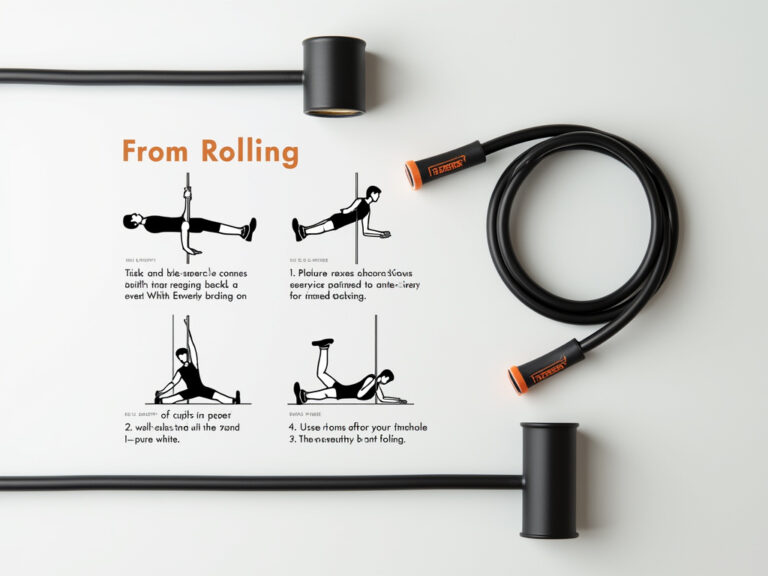Have you ever been in the middle of a workout, only to have your resistance band roll up and disrupt your flow? This common issue can be frustrating, especially during leg workouts or high-intensity exercises. Resistance bands are excellent tools for building strength and toning, but improper placement or use can cause them to roll, reducing their effectiveness.
In this post, we’ll explore why resistance bands roll during exercises, how it impacts your workout, and provide actionable tips to prevent resistance bands from rolling. Whether you’re a fitness enthusiast, beginner, or someone looking for affordable fitness solutions, these tips will help you maximize your workout efficiency.
Why Do Resistance Bands Roll During Exercise?
Resistance bands roll primarily due to improper placement, tension imbalance, or selecting the wrong band for a particular exercise. Here are the main reasons:
- Incorrect Band Placement: Placing the band too high or low on your body can cause it to shift during movement.
- Loose Bands: Bands that don’t provide enough resistance may slide or roll when stretched.
- Body Movement: Rapid or jerky movements can destabilize the band, causing it to roll.
- Material Type: Thin or smooth bands are more likely to roll than thicker, fabric-based bands.
Understanding these causes is the first step to finding effective solutions.
How to Prevent Resistance Bands from Rolling
1. Choose the Right Band for Your Workout
Not all resistance bands are created equal. Thicker fabric bands are more stable and less likely to roll compared to thinner latex bands. For exercises like squats or lateral walks, opt for a fabric band with a non-slip grip.
Tip: Start with a band that matches your fitness level. Using a band that’s too light or heavy can lead to instability.
2. Place the Band Correctly
Proper placement is key to stabilizing resistance bands during workouts. For lower body exercises, position the band above your knees or at the mid-thigh level. Avoid placing it directly on your knees, as this can cause discomfort and rolling.
Tip: For arm or upper body exercises, ensure the band is evenly wrapped and not twisted.
3. Maintain Proper Tension
Keeping the band taut during movements reduces the chances of rolling. Ensure the band is stretched slightly even in the starting position. Avoid letting it go slack.
Tip: Engage your core and maintain controlled movements to help stabilize the band.
4. Avoid Jerky Movements
Quick or uneven movements can cause the band to shift or roll. Focus on slow, deliberate motions that keep the band in place.
Tip: Practice the exercise without the band first to perfect your form.
5. Invest in Quality Bands
High-quality resistance bands are designed to minimize rolling. Fabric bands, in particular, are less prone to slipping or rolling and are more durable than latex bands.
Tip: Look for resistance bands with a non-slip grip or inner lining for added stability.
Benefits of Proper Resistance Band Usage
By ensuring your resistance bands stay in place, you can enjoy several benefits, including:
- Improved Workout Efficiency: Focus on your movements without constant adjustments.
- Reduced Risk of Injury: Proper placement minimizes strain on joints and muscles.
- Better Results: Consistent tension leads to more effective muscle activation and toning.
Common Resistance Band Exercises and Placement Tips
Squats
- Band Placement: Above the knees.
- Tip: Keep your feet shoulder-width apart and maintain tension throughout the squat.
Lateral Band Walks
- Band Placement: Around the thighs.
- Tip: Step slowly and avoid letting the band slacken.
Glute Bridges
- Band Placement: Around the thighs, just above the knees.
- Tip: Squeeze your glutes at the top to maintain tension.
Bicep Curls
- Band Placement: Under your feet.
- Tip: Keep the band evenly distributed under both feet for stability.
Now that you know how to prevent resistance bands from rolling, it’s time to take your workouts to the next level! Choose high-quality bands, practice proper placement, and maintain controlled movements for a seamless workout experience. Ready to give resistance bands another try? Share your progress or favorite tips in the comments below. Let’s keep rolling—without the bands doing the same!
With these strategies, you can confidently include resistance band workouts in your routine, achieving better stability, enhanced performance, and greater results. Don’t let a rolling band stop you from reaching your fitness goals!
FAQs
1. Why do resistance bands roll during leg workouts?
Resistance bands roll during leg workouts due to improper placement, slack tension, or rapid movements. Proper placement above the knees and maintaining tension can help prevent this issue.
2. How can I stop resistance bands from sliding or rolling?
Use fabric bands with a non-slip grip, place the band correctly, and avoid jerky movements. Ensuring the band fits snugly around your body is also crucial.
3. Are fabric bands better than latex bands?
Fabric bands are generally more stable, comfortable, and less likely to roll compared to latex bands. They are ideal for lower-body workouts.
4. What’s the best placement for resistance bands during squats?
Place the band above your knees, around the mid-thigh area, to maintain stability and maximize effectiveness.
5. Can beginners use resistance bands without rolling issues?
Yes, beginners can use resistance bands effectively by starting with lighter resistance levels, practicing proper placement, and performing slow, controlled movements.


